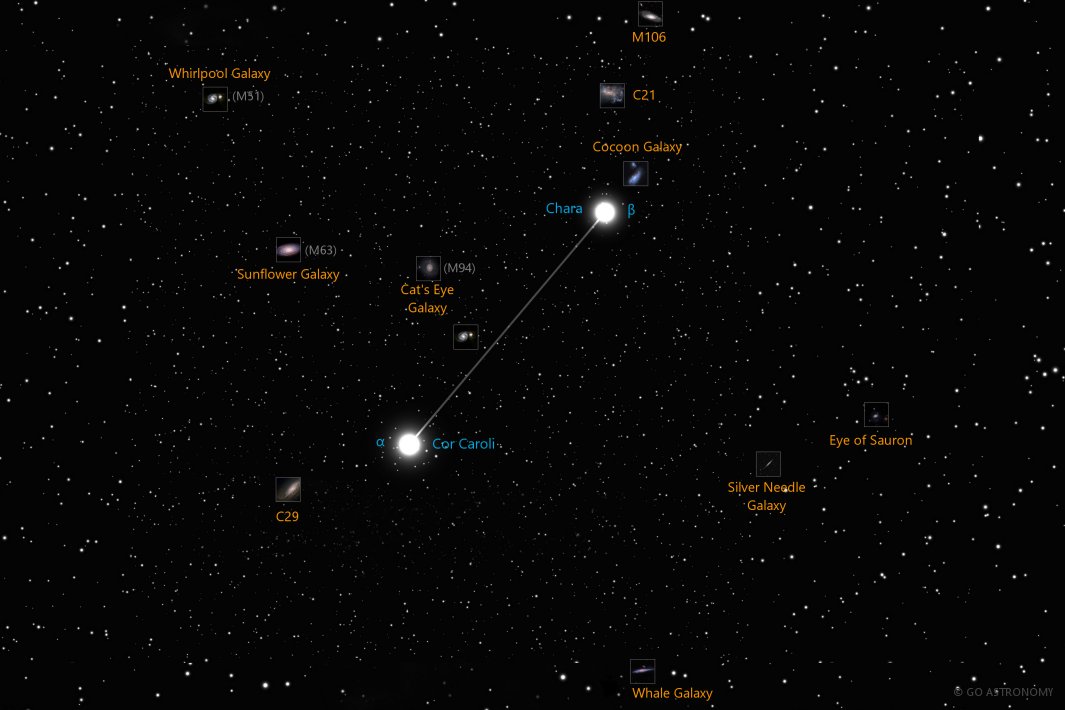Canes Venatici, the Hunting Dogs (CVn)
(CANE-eez ve-NAT-iss-eye)
The Northern constellation of Canes Venatici, the Hunting Dogs, is best viewed in Spring during the month of May.
Canes Venatici is the 38th largest constellation. It's brightest star is Asterion at magnitude 2.90. The boundary of the Canes Venatici constellation contains 4 stars that host known exoplanets.
- Pronunciation:
- CANE-eez ve-NAT-iss-eye
- Meaning:
- Hunting Dogs
- Genitive:
- Canem Venaticorum
- Abbreviation:
- CVn
- Constellation Family:
- Ursa Major
- Hemisphere:
- Northern
- Quadrant:
- NQ3
- Visibility:
- 90° N - 40° S
- Best viewing month*:
- May
- Area:
- 465 sq. degrees
- Size:
- 38th largest
- Right Ascension (avg):
- 13h 1m
- Declination (avg):
- 40°
- Brightest star:
- Asterion (2.90)
- Stars with planets:
- 4
Brightest Stars in Canes Venatici
The 10 brightest stars in the constellation Canes Venatici by magnitude.
- Star
- Magnitude
- Spectral class
- Alpha Canes Venaticorum (α2 Cvn)
- 2.89
- A0spe
- Beta Canes Venaticorum (β Cvn)
- 4.24
- G0V
- 24 Canes Venaticorum (24 Cvn)
- 4.68
- A5V
- 20 Canes Venaticorum (20 Cvn)
- 4.72
- F3III
- AW Canes Venaticorum (AW Cvn)
- 4.76
- K5III
- 5 Canes Venaticorum (5 Cvn)
- 4.77
- G7III
- 25 Canes Venaticorum (25 Cvn)
- 4.82
- A7III
- HR 5110
- 4.91
- F2IV SB
- HD 115004
- 4.94
- K0III
- 6 Canes Venaticorum (6 Cvn)
- 5.01
- G8III-IV
Double Stars in Canes Venatici
These are the brightest and easiest-to-find double, triple, and quadruple star systems in the constellation Canes Venatici . Also see all star clusters.
- Star system
- Magnitudes
- Type
- Alpha Canum Venaticorum
- 2.9, 5.5
- double
Star Clusters in Canes Venatici
The most notable and easy-to-find star clusters in the constellation Canes Venatici . Also see all star clusters.
Galaxies in Canes Venatici
The most notable galaxies in the constellation Canes Venatici . Also see all galaxies.
- Name
- Alt name
- Type
- Eye of Sauron Galaxy
- Seyfert
- Hockey Stick Galaxy
- galaxy pair
- Sunflower Galaxy
- M63
- spiral
- Whale Galaxy
- C32
- spiral
- Whirlpool Galaxy
- M51
- spiral
- Arp 193
- galaxy
- Arp 269
- galaxy pair
- Caldwell 21
- C21
- irregular
- Caldwell 29
- C29
- spiral
- Cat's Eye Galaxy
- M94
- spiral
- Cocoon Galaxy
- spiral
- Messier 106
- M106
- spiral
- NGC 4214
- spiral
- NGC 4618
- spiral
- NGC 4625
- spiral
- Silver Needle Galaxy
- C26
- spiral
- Whirlpool Galaxy
- M51
- galaxy pair
Milky Way Satellites in Canes Venatici
Dwarf satellite galaxies that orbit the Milky Way Galaxy located in the constellation Canes Venatici. Also see all Milky Way satellite galaxies.
- Galaxy name
- Alt name
- Magnitude
- Canes Venatici I
- 13.9
- Canes Venatici II
The Cosmic Hunting Dogs
Canes Venatici, Latin for "hunting dogs", is a small northern constellation that is home to several notable galaxies and deep-sky objects. Despite its relatively minor size, the constellation offers a wealth of fascinating celestial objects for both amateur and professional astronomers to explore.
Historical Background
Unlike many other constellations, Canes Venatici does not originate from ancient Greek or Roman mythology. It was introduced in the 17th century by Polish astronomer Johannes Hevelius, who was known for his detailed celestial charts. He depicted Canes Venatici as two dogs held on a leash by the neighbouring constellation, Bo?tes, the herdsman.
Location and Notable Features
Canes Venatici is located in the second quadrant of the Northern hemisphere (NQ2) and can be seen at latitudes between +90? and -40?. It's bordered by several constellations, including Ursa Major to the north and Bo?tes to the east.
The constellation has only two main stars, Cor Caroli and Chara, forming a line southeast of the handle of the Big Dipper. Cor Caroli, the brightest star in Canes Venatici, has an apparent magnitude of 2.9 and is approximately 110 light-years away from Earth. Chara, slightly fainter, serves as an important "yardstick" in the cosmic distance ladder due to its status as a solar analog.
Deep Sky Objects
Canes Venatici is a treasure trove of galaxies, being home to several Messier objects. The most famous of these is the Whirlpool Galaxy (M51), one of the most beautiful face-on spiral galaxies visible from Earth. Its design, with well-defined spiral arms, has made it a favorite target for astronomers.
Other notable galaxies include the Sunflower Galaxy (M63), a spiral galaxy with a bright yellowish core, and the Whale Galaxy (NGC 4631), so named because of its elongated, s-shaped form.
In addition to these galaxies, Canes Venatici also houses the globular cluster M3, one of the largest and brightest clusters in the sky, containing an estimated half a million stars.
Observing Canes Venatici
Canes Venatici can be best seen in the month of May, but it's visible from spring to late summer in the Northern Hemisphere. Though its main stars are relatively faint, they can be located by tracing a line from the handle of the Big Dipper.
The deep-sky objects within Canes Venatici, particularly M51 and M3, are a treat for astronomers equipped with telescopes. However, due to their faintness, these objects are best viewed from a location with minimal light pollution.
* Constellation shown for northen hemisphere skies. For the southern hemisphere, constellations appear rotated 180 degrees (upside-down and left-right reversed) from what is shown. Remember that seasons are reversed too - summer in northern latitudes is winter in southern latitudes.
** Circumpolar constellations are visible year-round in the hemisphere listed (and not at all in the opposite hemisphere).





